FW
Indian exhibitors are pleased with the turnout of overseas buyers at the 48th edition of IHGF-Delhi fair. The fair is being held from October 16-20, 2019 at India Expo Centre & Mart in New Delhi.
First time visitors to the show Omaya Sisemore of Earths’s Treasures from USA and Antoinette Stander from South Africa were surprised to see a large variety of Indian products on display by over 3,200 Indian exhibitors.
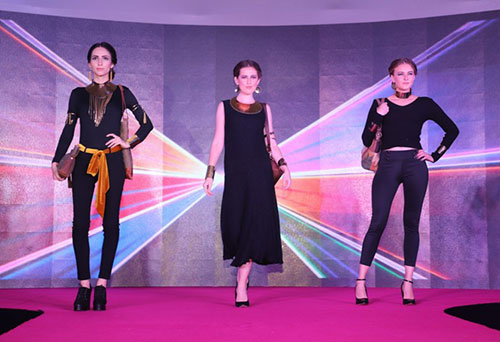
Similarly, Jesica Wilson from USA who has been visiting this show for the last five years noted that this edition focused more on the Reuse and Recycle theme to increase environment consciousness in India. She also said confirmed her visit to the next edition of the fair that will be held from April 15-19, 2020.
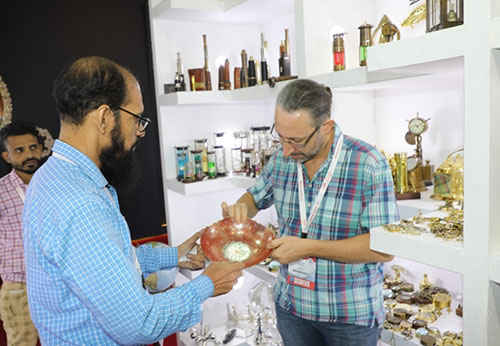
Another buyer from UK, Susan Redford was visiting the show for the 26th time in the last 20 years. She purchases accessories, home décor, gifts, furniture and incense for her company Namaste Ltd from the fair. According to her, the fair has got better with time as it keeps introducing new initiatives every year.
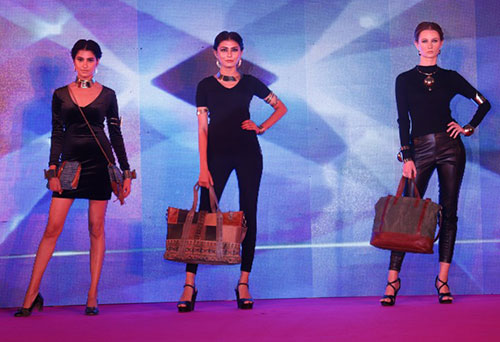
One of the main attractions of the fair included a fashion show on second day. This show had models walking on the on ramps displaying attires, fashion jewellery and accessories contributed by the exhibitors such as Krocks Jewellery, Oriental Exports, Sia Crafts, Vinayak Exports, Kenway Sartaj.
 Tokyo-based Image Magic has expanded its longstanding digital direct-to-garment capabilities by installing two Kornit Avalanche Poly Pro systems. The move supplements Image Magic’s continuous development of internal efficiencies, and increases its capacity for an operation that has observed 40 per cent year-over-year growth.
Tokyo-based Image Magic has expanded its longstanding digital direct-to-garment capabilities by installing two Kornit Avalanche Poly Pro systems. The move supplements Image Magic’s continuous development of internal efficiencies, and increases its capacity for an operation that has observed 40 per cent year-over-year growth.
Using the eco-friendly NeoPigment™ Olympia ink set, Kornit Avalanche Poly Pro was developed to extend digital design complexity, color gamut, and durability to polyesters, which have grown in popularity as a result of sportswear and ‘athleisure’ trends. It is the first digital direct-to-garment print system developed specifically for such materials.
Kornit Digital develops, manufactures and markets such industrial digital printing technologies for the garment, apparel and textile industries. The company delivers complete solutions, including digital printing systems, inks, consumables, software and after-sales support. It caters directly to the changing needs of the textile printing value chain. Kornit’s technology enables innovative business models based on web-to-print, on-demand and mass customisation concepts. With its immense experience in the direct-to-garment market, Kornit also offers a revolutionary approach to the roll-to-roll textile printing industry: The brand serves a mix of corporate clients, including some of Japan’s leading apparel brands, and general consumers via a predominantly internet-based sales model.
"Digitisation is taking the fashion industry by storm with many fashion e-commerce companies achieving the unicorn status in the industry. A prominent example of this is the Singapore-based privately held e-commerce start-up Zilingo which is digitising the entire fashion supply chain by unifying the HR systems, logistics APIs and operating systems of over of its 4,000 sourcing partners across the world. This has helped the company to reach $1 billion revenues in a short period of time."
 Digitisation is taking the fashion industry by storm with many fashion e-commerce companies achieving the unicorn status in the industry. A prominent example of this is the Singapore-based privately held e-commerce start-up Zilingo which is digitising the entire fashion supply chain by unifying the HR systems, logistics APIs and operating systems of over of its 4,000 sourcing partners across the world. This has helped the company to reach $1 billion revenues in a short period of time.
Digitisation is taking the fashion industry by storm with many fashion e-commerce companies achieving the unicorn status in the industry. A prominent example of this is the Singapore-based privately held e-commerce start-up Zilingo which is digitising the entire fashion supply chain by unifying the HR systems, logistics APIs and operating systems of over of its 4,000 sourcing partners across the world. This has helped the company to reach $1 billion revenues in a short period of time.
In future, the company also plans to incorporate transparency programs that will give it a direct oversight of quality-control issues at the factory level through the provision of real-time data. By using proprietary quality-control modules, the company’s line managers will use connected tablets and a heat map to detect problem areas in their products.
Technology drives growth in apparel companies
Zilingo is thus symptomatic of the rapid advances reshaping the sourcing and apparel industries with tech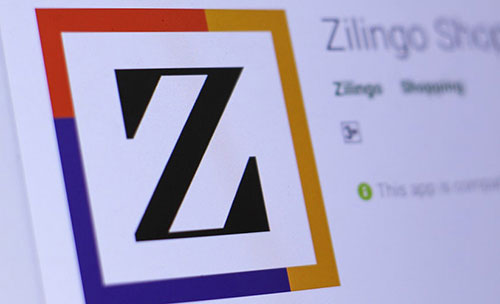 companies driving the change. Signs of this shift was evident at this year's ‘Sourcing at One Magic’ event, hosted in Las Vegas recently. Many companies attending the event were looking for new ways to navigate the volatility caused by the recent tariff hikes, improve their delivery times and be more sustainable by harnessing the value of big data.
companies driving the change. Signs of this shift was evident at this year's ‘Sourcing at One Magic’ event, hosted in Las Vegas recently. Many companies attending the event were looking for new ways to navigate the volatility caused by the recent tariff hikes, improve their delivery times and be more sustainable by harnessing the value of big data.
Like Zilingo, the growth of New York-based The Ohzone, has also been driven by the rise of e-commerce platforms and the race to deliver ever more effective online visual search technology in the clothing sector. The fashion technology company specialises in the creation of precise 3-D, zoomable models of real garments. These can be used to market the garment on the Shopify e-commerce platform, as well as to test outfits and change out elements without the need for any inevitably wasteful sampling. The company plans to push the digital apparel envelope further by creating digital-only clothing.
Digital closets gain popularity
The idea of creating a digital closet is rapidly gaining ground with many designers producing photo-realistic, digital-only collections. A prime example of this is the Scandinavian retailer Carlings, with its digital tailors manipulating its client's photos so it appeared that they were wearing the company's limited-run finery – and all at a very real world $30 per piece. Similarly, Moscow-based fashion influencer Daria Simonova modeled her Carlings'3-D collection to her 56,000 followers on Instagram, with her photo of a puffer jacket paired with lightning bolt-embellished jeans notching up more than 4,700 likes.
The power of mobile games
One way brands can leverage the potential of digital closets is through mobile gaming. For instance, Glu Mobile's Covet Fashiongame enables players to style their models in digitally rendered clothing and accessories – brought in $53.4 million in sales last year. Similarly, San Francisco-based company's Kim Kardashian: Hollywood game, allows users to dress an avatar – presumably an amply derriered one – in designer garments, has generated more than $240 million in sales since it was launched in 2014. Meanwhile, the first digital couture dress – created by The Fabricant, an Amsterdam-based fashion label – fetched $9,500 at auction in May.
Digital designerwear is thus on its way to become the next fast fashion with the apparel industry dramatically upping its uptake of IT engineers.
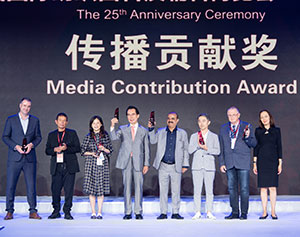 FashionatingWorld, the leading global network of webplatforms, steered by DFU Publications, was graced with Media Contribution Award at the Intertextile Shanghai Apparel Fabrics show in Shanghai. The global media company that has been associated with Intertextile Shanghai events for a long time.
FashionatingWorld, the leading global network of webplatforms, steered by DFU Publications, was graced with Media Contribution Award at the Intertextile Shanghai Apparel Fabrics show in Shanghai. The global media company that has been associated with Intertextile Shanghai events for a long time.
Sanjay Chawla, Global Convener, Publisher & Editor in Chief received the awards among few other media dignitaries. This comes as a high recognition being conferred by the biggest apparel fabrics exhibition in the world.
Intertextile Shanghai Apparel Fabrics celebrated its 25th anniversary on September 25, 2019, The trade show awarded leading industry players, experts, trade bodies , exhibitors as well as buyers , who have had a prominent association with Intertextile Shanghai exhibition, all these years.
Polartec, a provider of sustainable textile solutions, has unveiled the iconic, American-made, military-issue fabric technologies and finished garments, for Americans. Available directly from the source, these authentic Polartec fabrics and designs are shipped directly from the same US cut and sew manufacturers that have been creating these garments since 2007.
The foundation of the brand’s Gen III Extended Cold Weather Clothing System (ECWCS) is its Polartec Military Issue Collection. This ECWCS system provides soldiers with a multi-layered, performance driven clothing system that is designed to be versatile and adaptable to varying operational and environmental conditions.
For more than a decade there have been Gen III ECWCS labelled military garment designs for sale online and from select military retail stores. While some of these items are authentic surplus garments, it remains an unregulated grey area. Foreign imitations continue to pop up in their various forms, and even outdoor sporting and hunting brands have adopted military issue garment nomenclature into product descriptions.
Now available directly from the source, these authentic Polartec fabrics and designs are made in America and shipped directly from the same US cut and sew manufacturers that have been creating these garments since 2007.
Japanese Company Uniqlo plans to launch its third store in Madrid, Spain. The brand currently operates two stores in Barcelona. It will open its Madrid store three years after it forayed into the Spanish market. The store will be located in the former El Jardin de Serrano shopping mall and span over 1,500 sq m and is located in the former El Jardín de Serrano shopping mall.
The company plans to open this department store in partnership with El Corte Ingles, one of the largest fashion distributors in Spain and the main stop for international operators who want to gain insight in the country. In 2017, the group’s revenue was 4.9 billion euros with this sector, above what Inditex entered in Spain in the same year.
Together with groups like Levi’s, Ralph Lauren or Esprit, which rely on department stores in their international expansion, or luxury brands such as Dior, Bottega Veneta or Dolce&Gabbana, in El Corte Inglés also operate brands that, like Uniqlo, concentrate the bulk of its distribution in retail.
Saurer will present its new air-spinning machine Autoairo at CIIE that will be held from November 05-10, 2019.
The Autoairo features autonomous spinning positions with individual drives and integrated intelligence. Its digital piecing unit is capable of performing up to 24 piecing processes simultaneously. As a result, the machine’s run-up time is also reduced by at least 30 per cent. The Autoairo’s compact, double-sided design means that it takes up 40 per cent less space than single-sided machines. These features give the Autoairo a powerful productivity advantage, while at the same time lowering spinning costs.
This innovation significantly increases efficiency. It is fully automated with autonomous, intelligent spinning positions, revolutionising air spinning. With Autoairo, spinning mills can produce high-quality yarn more quickly, more cost-efficiently and more flexibly.
With more than 160 years’ experience, Saurer has always been committed to advancing the textile industry, integrating high-end equipment manufacturing with modern information technology to provide complete solutions for the smart spinning factory.
Prada’s fall/winter line Linea Rossa has a strong military theme.
There are lots of khaki and battleship grey officer’s raingear, parkas and hooded trenches – all finished with the signature white on red logo strip. Active sports gear has bright primary color ski pants and ski-boarder jackets. Tough chic black is a running theme in the mini hooded bolero puffers in black nylon worn over graphic anthracite leggings and chunky mountaineers sneakers. The look is protective but with plenty of panache. Everything is made in forward-thinking fabrics – from the graphene and recycled polyester padding, conductive and reactive fabrics like Tela Tecnica Pro and seamless knits that are pH-balanced for a hyperallergic effect – reducing moisture and minimizing odors.
After a hiatus of over a decade, Prada relaunched Linea Rossa last year, upgrading the collection’s scientific element and positioning its price point further up the chain.
Streamlined engineering is the new buzzword at Prada. In a novel move, Prada rolled out its latest ideas internationally with a series of presentations in boutiques and outside events in several countries. It was all about savoir-faire meeting urban and active sportswear. In Paris, Prada showed around 40 looks on mannequins inside its flagship, while in London it collaborated with Willow Smith, who staged an impromptu live performance.
Jeanologia is collaborating with international universities and bodies to develop a more efficient, sustainable and transparent textile industry by supporting a new training model that addresses the needs of digitalisation and transformation in the textile industry.
The training includes master classes, talks, sustainable finishing training, collaborations with capsule collections, talent rewarding, teaching on digital transformation strategies, on sustainable design and on circular economy, at some of its centers across the world.
The schools with which Jeanologia is collaborating includes the Parsons Art and Design School, the Fashion Institute of Technology in New York, Ravensbourne University in London, Fashion Design School in Singapore, National Textile University in Pakistan, I-Skool Denim and Jeans School in Amsterdam .
Jeanologia started up The School in 2013. This training grant provides designers with an opportunity to acquire all of the skills and knowledge necessary in design for textile laser, textile production techniques, sustainable design and denim product development.
The company provides a complete range of services to its clients since the selected students have four months of advanced training and after that, they have the possibility to be hired by these clients and work at their production centres around the five continents.
Increase in health awareness is shifting the focus of Indian consumers toward sportswear.
The Indian sports apparel market is segmented based on end user and mode of sale. By end user, the market is categorised into men, women, and children. On the basis of mode of sale, it is segregated into retail stores, super markets, brand outlets, discount stores, and online stores.
Sports apparel includes tracksuits, gym suits, yoga wear, swim wear, and tights. Such clothing has advantages like prolonged durability, improved range of motion, breathability of material, and superior comfort. They avert ligament injuries and physical strain on muscles and enhance performance. Endorsements of sportswear by celebrities influence the growth of the market. Additionally, Indian icons who consider themselves as fitness conscious promote apparel brands, which acts as a major driving factor of the sportswear segment, thereby contributing in expanding the customer base. The Indian sportswear industry is benefiting from the increasingly organized modern retail, consisting of a planned approach to distribution and logistics management, targeting urban as well as smaller developing towns. This is viewed as an opportunity by sportswear manufacturers. However, the counterfeit trade in sportswear is restraining the growth of the market.
Major players in the Indian sports apparel market include Adidas, Nike, Puma and Fila.












